History of major advances in medicine, social medicine

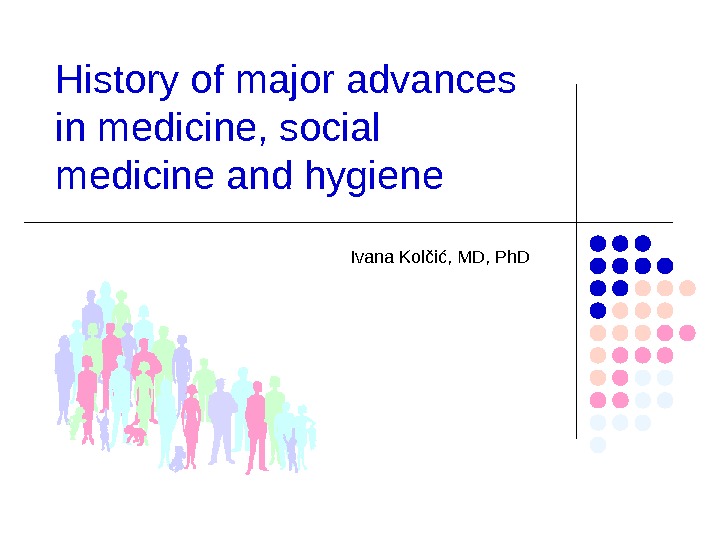
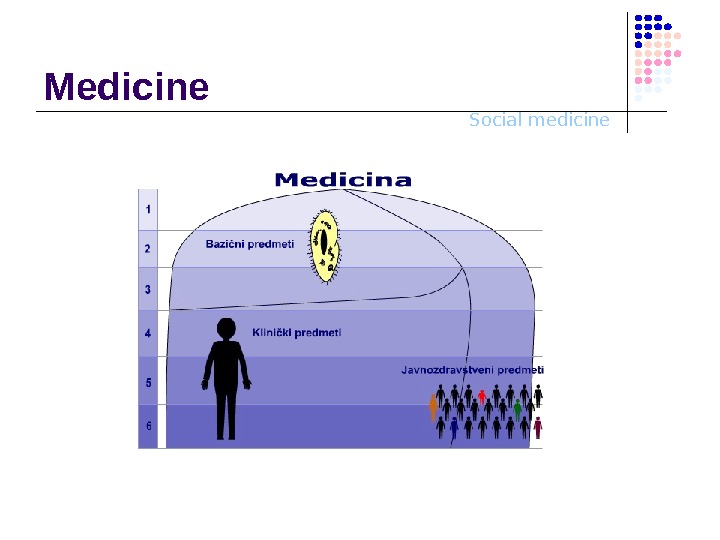

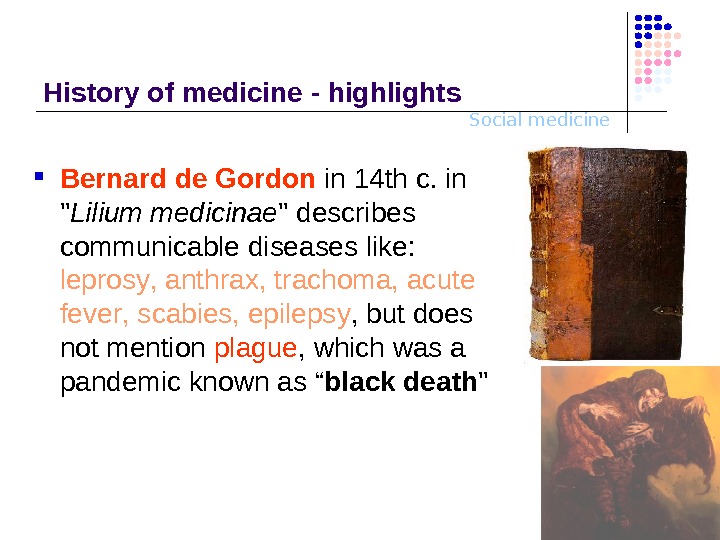
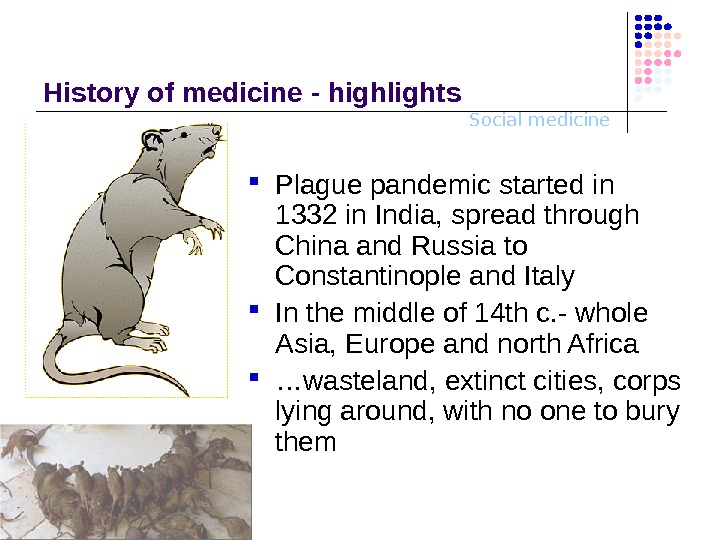
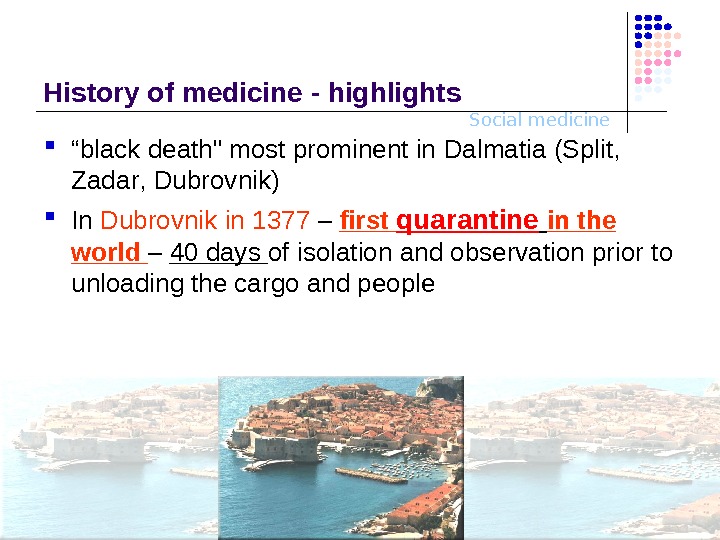
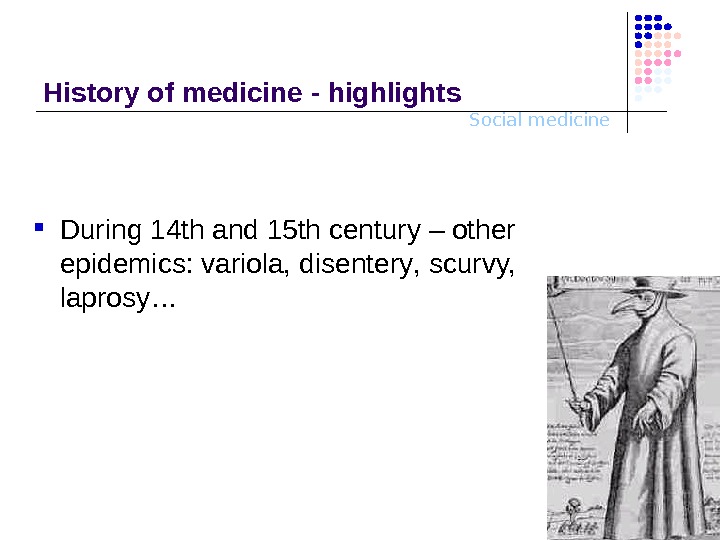
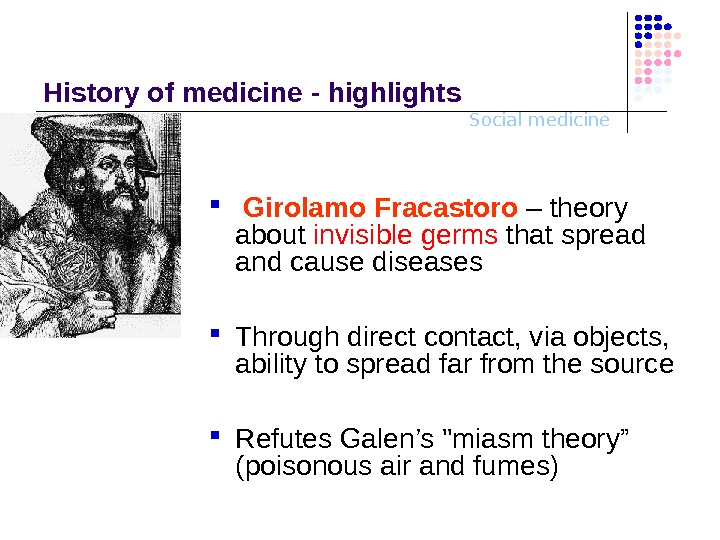
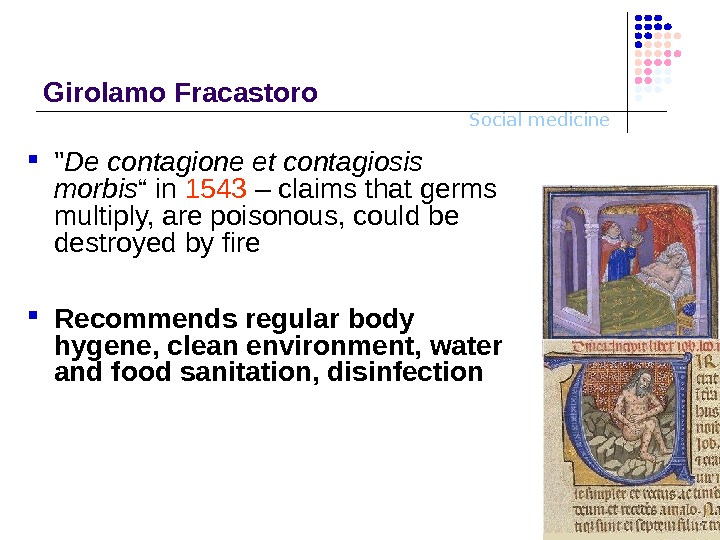
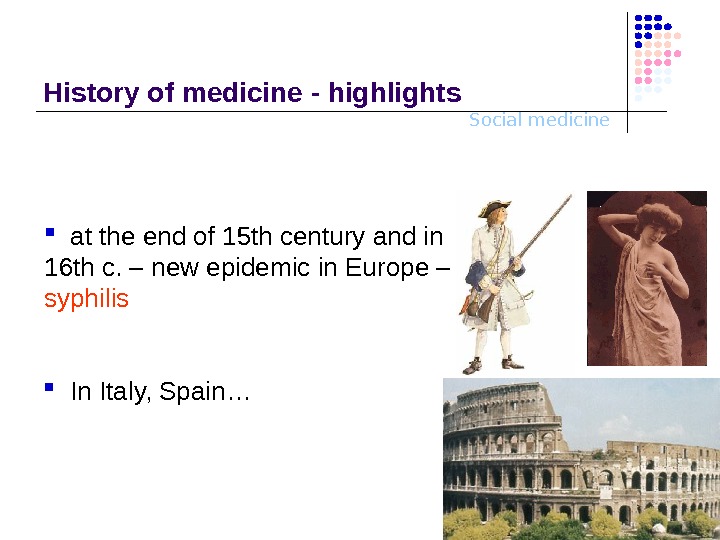
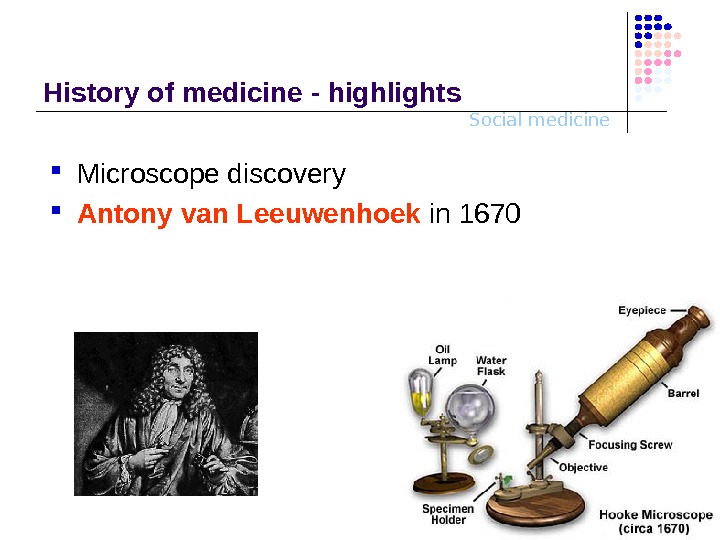
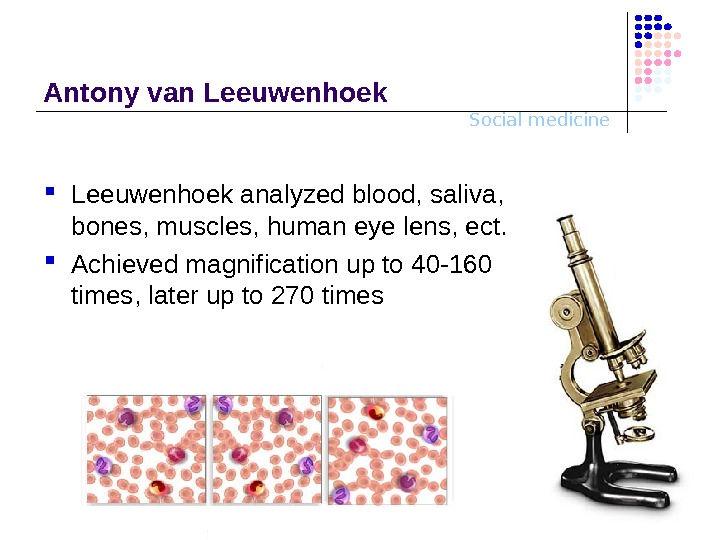

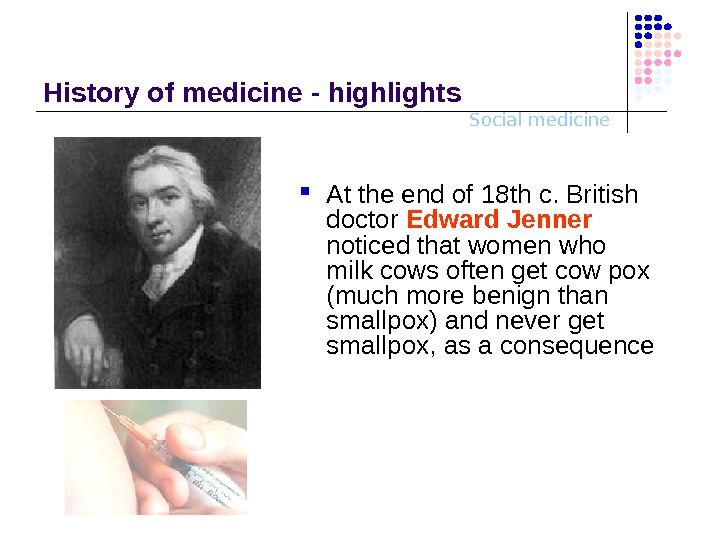
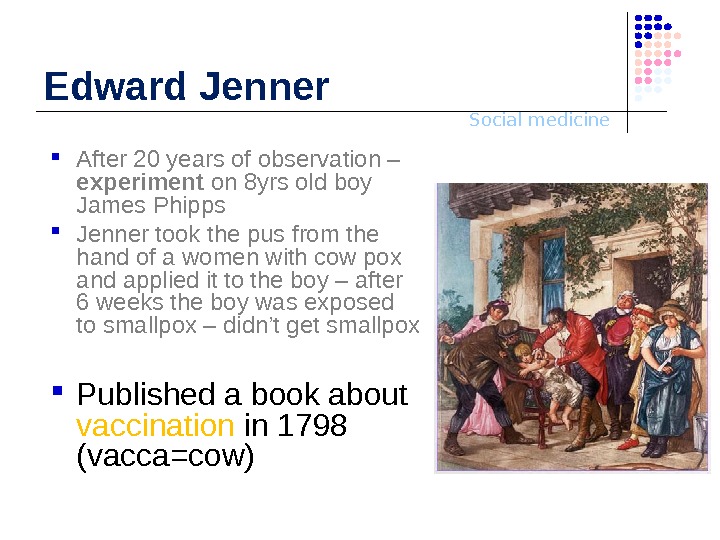

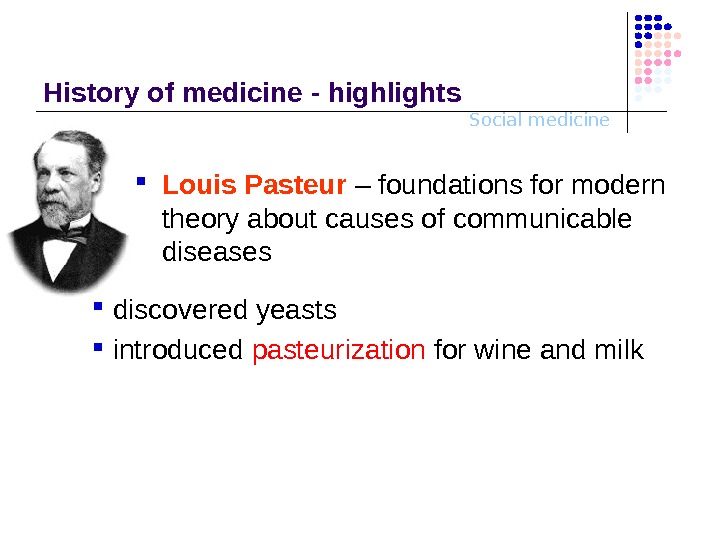
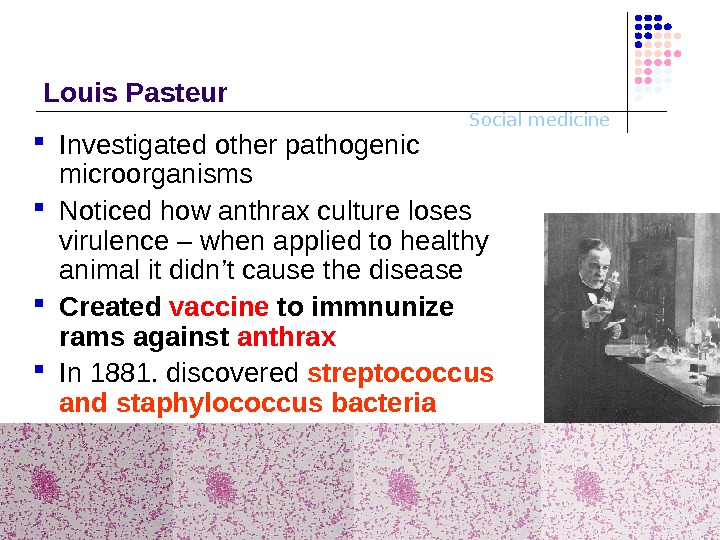
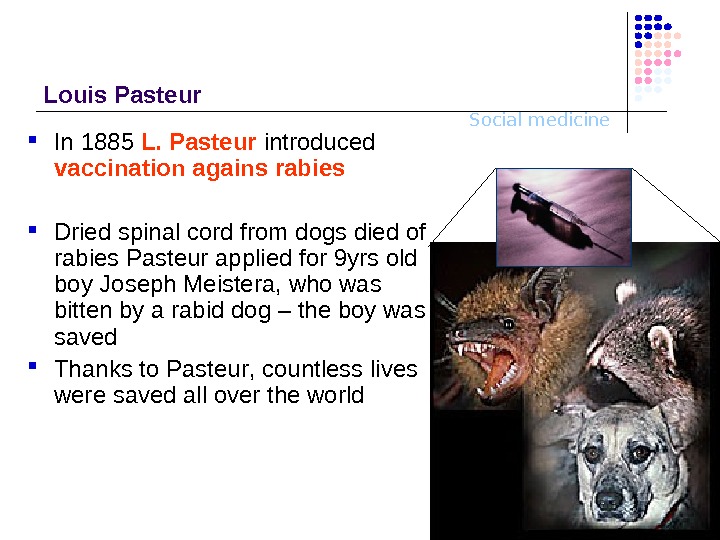
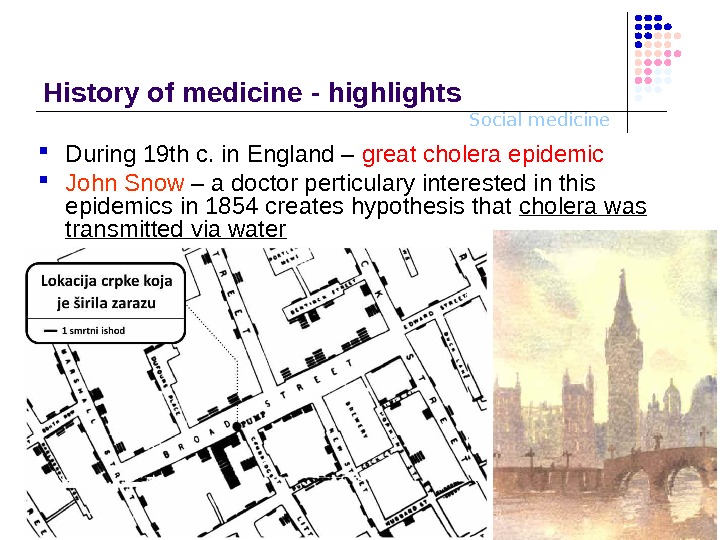

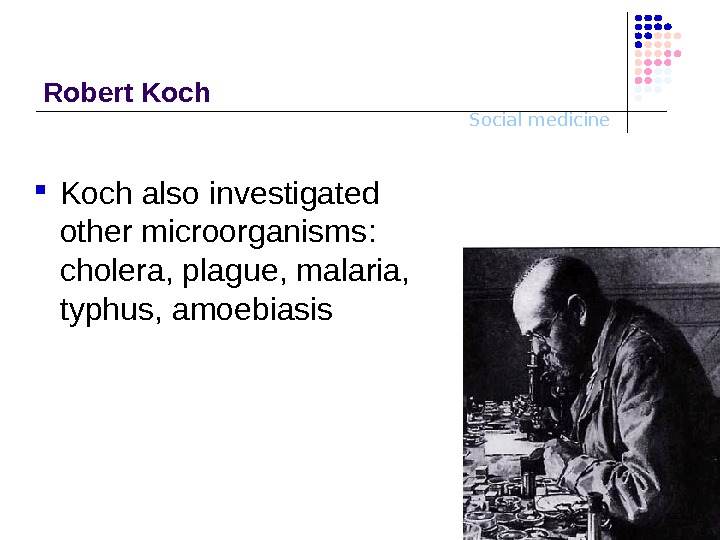
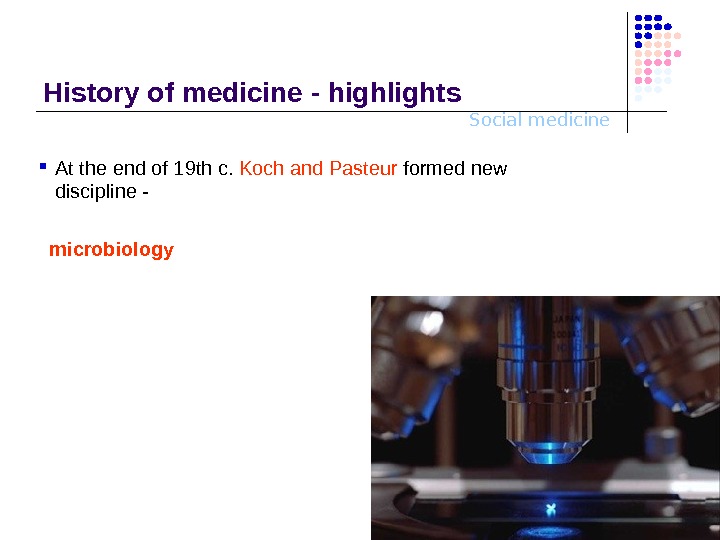
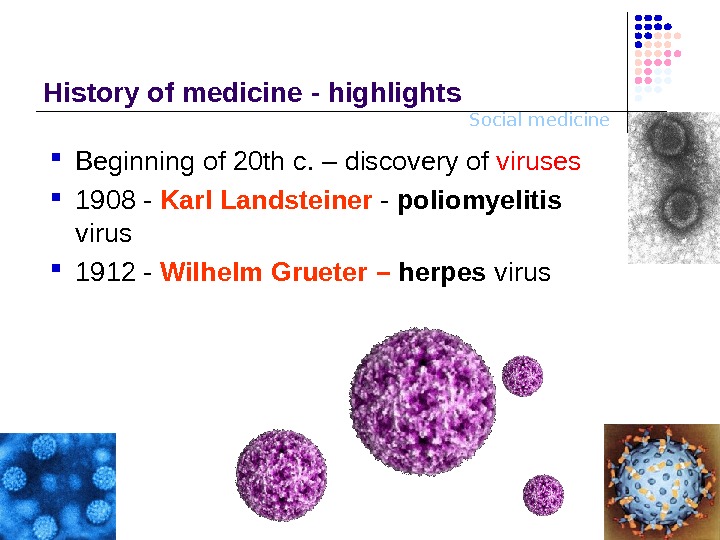
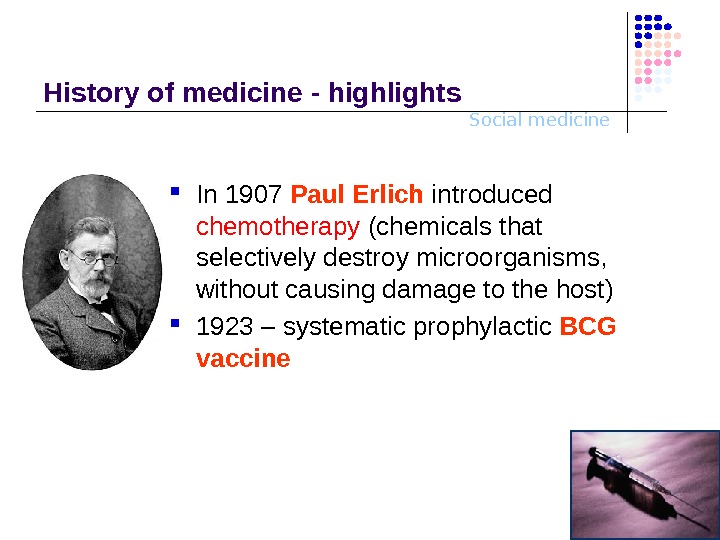
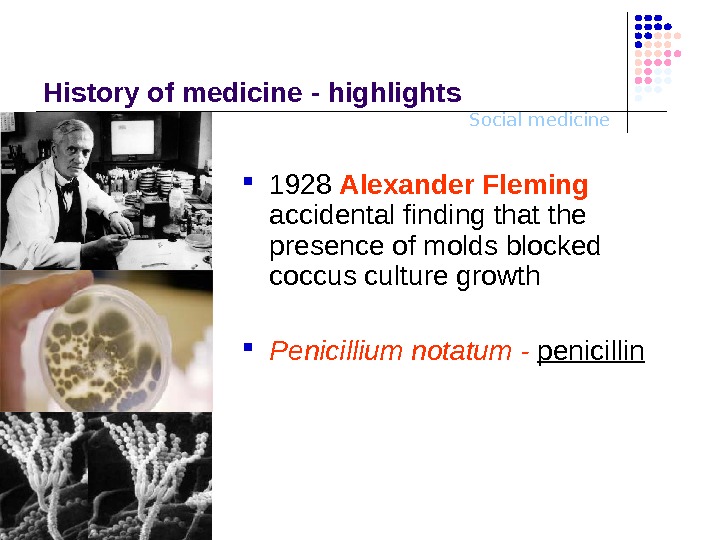
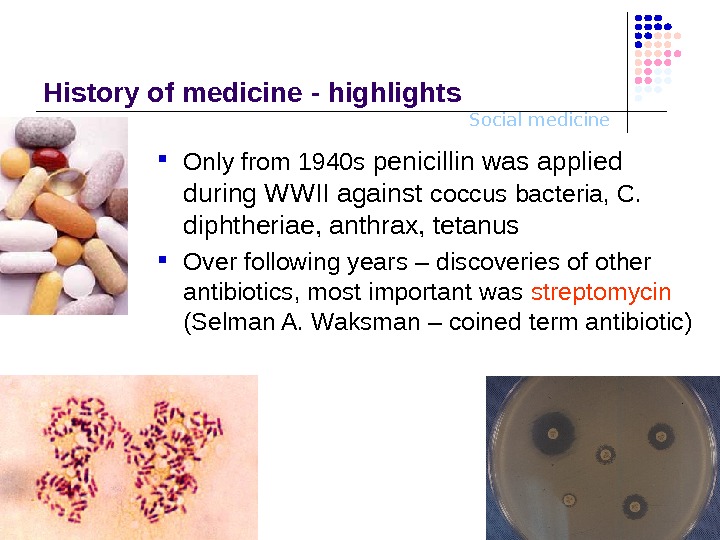
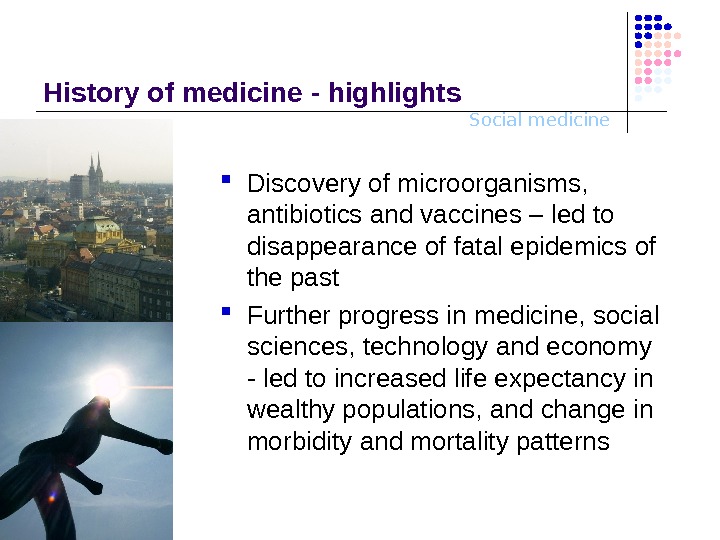
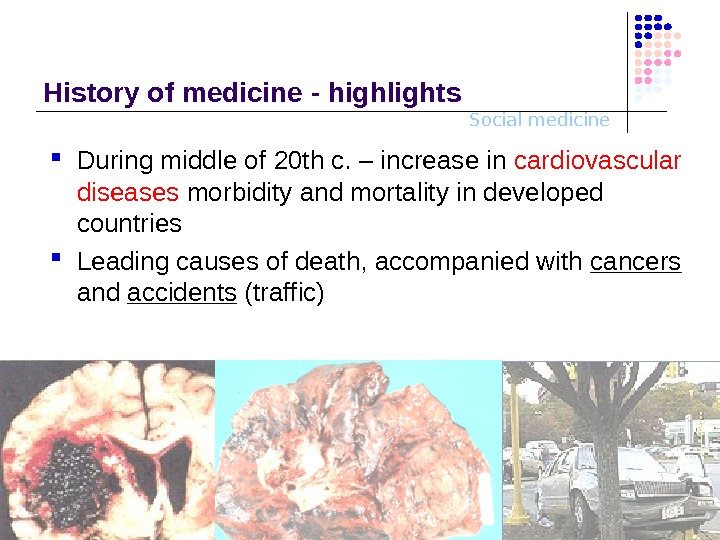
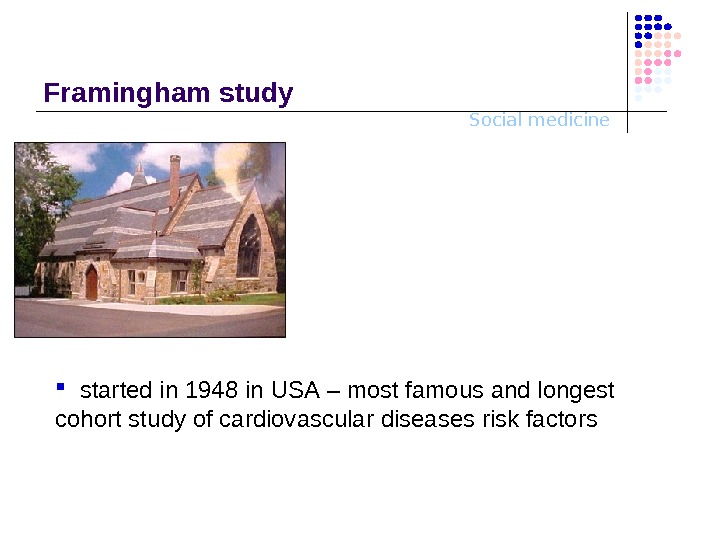
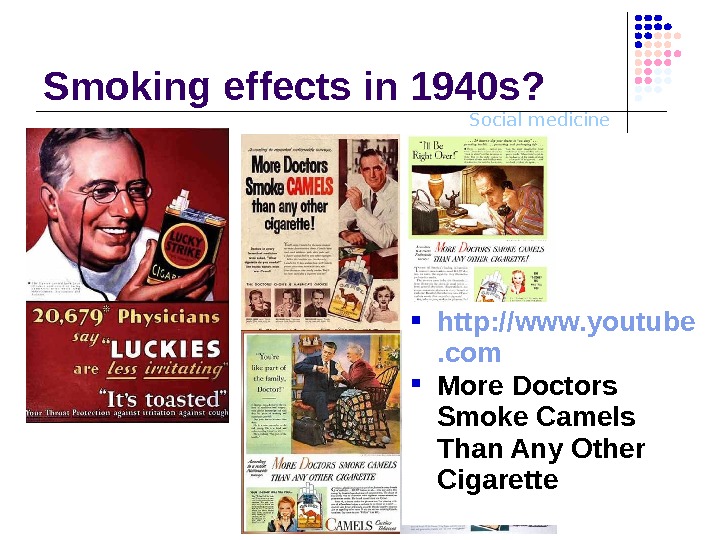
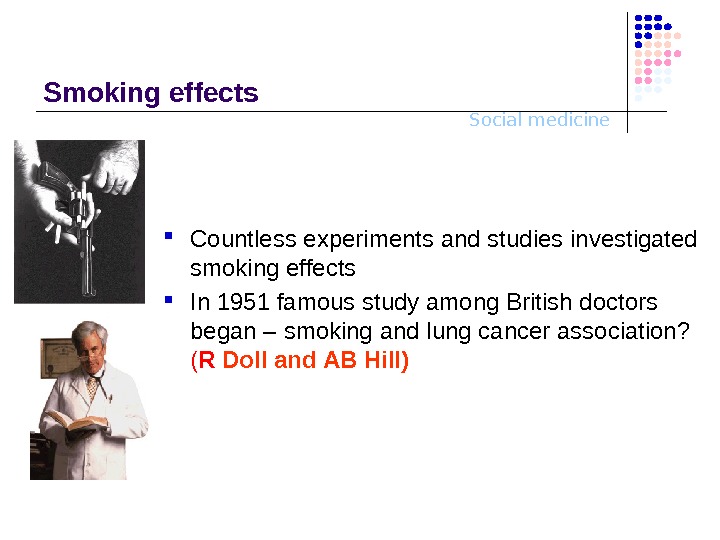
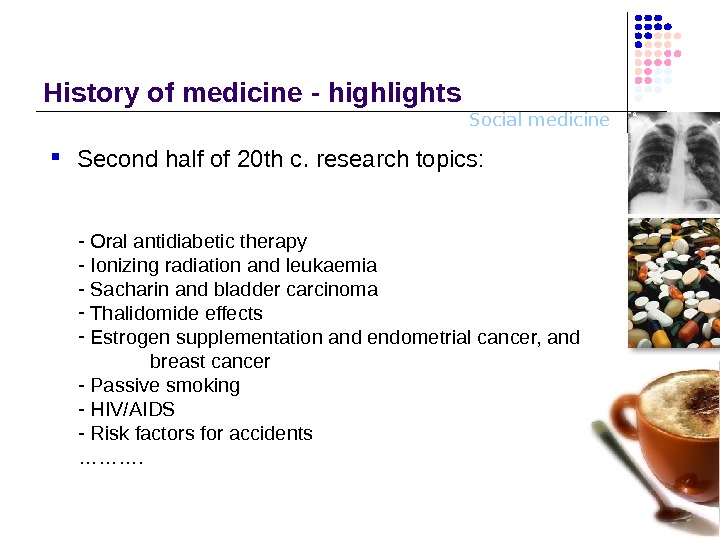
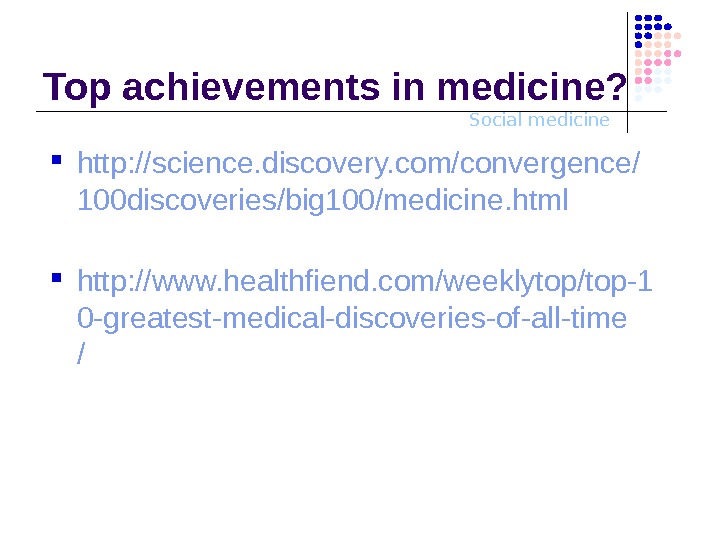
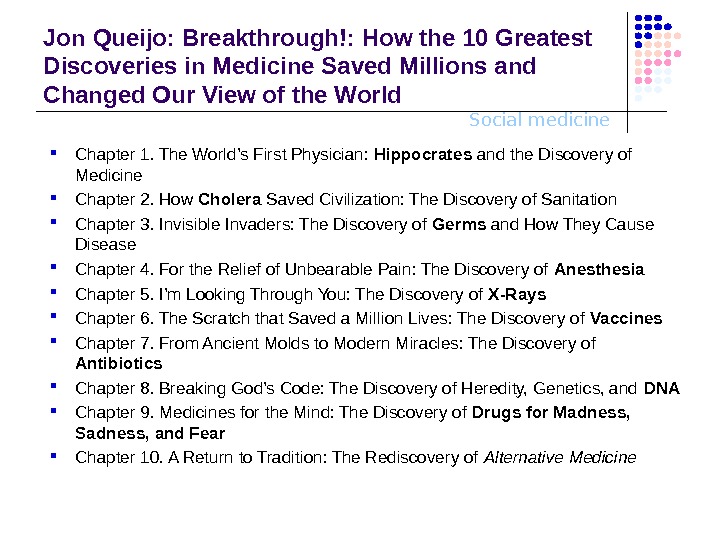
6_history_of_major_advances_in_medicine.ppt
- Размер: 3.2 Mегабайта
- Количество слайдов: 35
Описание презентации History of major advances in medicine, social medicine по слайдам
 History of major advances in medicine, social medicine and hygiene Ivana Kolčić, MD, Ph.
History of major advances in medicine, social medicine and hygiene Ivana Kolčić, MD, Ph.
 Social medicine. Medicine
Social medicine. Medicine
 Social medicine. History o f medicine — highlights e pidemi cs – well known through all of the human history Until 16 th century every disease in epidemic proportion = » pestis » or » pestilentia «
Social medicine. History o f medicine — highlights e pidemi cs – well known through all of the human history Until 16 th century every disease in epidemic proportion = » pestis » or » pestilentia «
 Social medicine. History o f medicine — highlights Bernard de Gordon in 14 th c. in » Lilium medicinae » describes communicable diseases like : lepr osy , ant h ra x , tra c hom a , a c ute fever , s c abies, epileps y , but does not mention plague , which was a pandemic known as “ black death «
Social medicine. History o f medicine — highlights Bernard de Gordon in 14 th c. in » Lilium medicinae » describes communicable diseases like : lepr osy , ant h ra x , tra c hom a , a c ute fever , s c abies, epileps y , but does not mention plague , which was a pandemic known as “ black death «
 Social medicine. History o f medicine — highlights Plague pandemic started in 1332 in Indi a, spread through China and Rus s i a to Constantinople and Italy In the middle of 14 th c. — whole Asia, Europe and north Africa … wasteland, extinct cities, corps lying around, with no one to bury them
Social medicine. History o f medicine — highlights Plague pandemic started in 1332 in Indi a, spread through China and Rus s i a to Constantinople and Italy In the middle of 14 th c. — whole Asia, Europe and north Africa … wasteland, extinct cities, corps lying around, with no one to bury them
 Social medicine. History o f medicine — highlights “ black death » most prominent in Dalma tia ( Split, Zad a r , Dubrovnik ) In Dubrovnik in 1377 – first quarantine in the world – 40 days of isolation and observation prior to unloading the cargo and people
Social medicine. History o f medicine — highlights “ black death » most prominent in Dalma tia ( Split, Zad a r , Dubrovnik ) In Dubrovnik in 1377 – first quarantine in the world – 40 days of isolation and observation prior to unloading the cargo and people
 Social medicine. History o f medicine — highlights During 14 th and 15 th century – other epidemics: variola, di s enter y , scurvy, laprosy…
Social medicine. History o f medicine — highlights During 14 th and 15 th century – other epidemics: variola, di s enter y , scurvy, laprosy…
 Social medicine. History o f medicine — highlights Girolamo F r acastoro – theory about invisible germs that spread and cause diseases Through direct contact, via objects, ability to spread far from the source Refutes Galen ’s «mia sm theory ” (poisonous air and fumes)
Social medicine. History o f medicine — highlights Girolamo F r acastoro – theory about invisible germs that spread and cause diseases Through direct contact, via objects, ability to spread far from the source Refutes Galen ’s «mia sm theory ” (poisonous air and fumes)
 Social medicine. Girolamo F r acastoro » De contagione et contagiosis morbis “ in 1543 – claims that germs multiply, are poisonous, could be destroyed by fire Recommends regular body hygene, clean environment, water and food sanitation, disinfection
Social medicine. Girolamo F r acastoro » De contagione et contagiosis morbis “ in 1543 – claims that germs multiply, are poisonous, could be destroyed by fire Recommends regular body hygene, clean environment, water and food sanitation, disinfection
 Social medicine. History o f medicine — highlights In Ital y, Spain… at the end of 1 5 th century and in 16 th c. – new epidemic in Europe – s yph ilis
Social medicine. History o f medicine — highlights In Ital y, Spain… at the end of 1 5 th century and in 16 th c. – new epidemic in Europe – s yph ilis
 Social medicine. History o f medicine — highlights Microscope discovery Antony van Leeuwenhoek in
Social medicine. History o f medicine — highlights Microscope discovery Antony van Leeuwenhoek in
 Social medicine. Antony van Leeuwenhoek analyzed blood, saliva, bones, muscle s , human eye lens, ect. Achieved magnification up to 40 -160 times , later up to 270 times
Social medicine. Antony van Leeuwenhoek analyzed blood, saliva, bones, muscle s , human eye lens, ect. Achieved magnification up to 40 -160 times , later up to 270 times
 Social medicine. History o f medicine — highlights In 18 th c. doctor from Slovenia Marko Anton Plenčić supports theory about small living creatures which cause communicable diseases He hypothesized that different creature causes different, specific disease Described human immunity, susceptibility, incubation, disease carriers, some diseases (scarlet fever, variola)
Social medicine. History o f medicine — highlights In 18 th c. doctor from Slovenia Marko Anton Plenčić supports theory about small living creatures which cause communicable diseases He hypothesized that different creature causes different, specific disease Described human immunity, susceptibility, incubation, disease carriers, some diseases (scarlet fever, variola)
 Social medicine. History o f medicine — highlights At the end of 18 th c. British doctor Edward Jenner noticed that women who milk cows often get cow pox ( much more benign than smallpox) and never get smallpox, as a consequence
Social medicine. History o f medicine — highlights At the end of 18 th c. British doctor Edward Jenner noticed that women who milk cows often get cow pox ( much more benign than smallpox) and never get smallpox, as a consequence
 Social medicine. Edward Jenner After 20 years of observation – experiment on 8 yrs old boy James Phipps Jenner took the pus from the hand of a women with cow pox and applied it to the boy – after 6 weeks the boy was exposed to smallpox – didn’t get smallpox Published a book about vaccination in 1798 (vacca=cow)
Social medicine. Edward Jenner After 20 years of observation – experiment on 8 yrs old boy James Phipps Jenner took the pus from the hand of a women with cow pox and applied it to the boy – after 6 weeks the boy was exposed to smallpox – didn’t get smallpox Published a book about vaccination in 1798 (vacca=cow)
 Social medicine. History o f medicine — highlights Only in 19 th century bacteria have been discovered Pollender discovered one of the largest bacteria — anthrax in the blood of dead animals
Social medicine. History o f medicine — highlights Only in 19 th century bacteria have been discovered Pollender discovered one of the largest bacteria — anthrax in the blood of dead animals
 Social medicine. History o f medicine — highlights Louis Pasteur – foundations for modern theory about causes of communicable diseases discovered yeasts introduced pasteurization for wine and milk
Social medicine. History o f medicine — highlights Louis Pasteur – foundations for modern theory about causes of communicable diseases discovered yeasts introduced pasteurization for wine and milk
 Social medicine. Louis Pasteur Investigated other pathogenic microorganisms Noticed how anthrax culture loses virulence – when applied to healthy animal it didn’t cause the disease Created vaccine to immnunize rams against anthrax In 1 881. discovered strepto coccus and sta phy lo coccus bacteria
Social medicine. Louis Pasteur Investigated other pathogenic microorganisms Noticed how anthrax culture loses virulence – when applied to healthy animal it didn’t cause the disease Created vaccine to immnunize rams against anthrax In 1 881. discovered strepto coccus and sta phy lo coccus bacteria
 Social medicine. Louis Pasteur In 1885 L. Pasteur introduced va c cina tion agains rabies Dried spinal cord from dogs died of rabies Pasteur applied for 9 yrs old boy Joseph Meistera, who was bitten by a rabid dog – the boy was saved Thanks to Pasteur , countless lives were saved all over the world
Social medicine. Louis Pasteur In 1885 L. Pasteur introduced va c cina tion agains rabies Dried spinal cord from dogs died of rabies Pasteur applied for 9 yrs old boy Joseph Meistera, who was bitten by a rabid dog – the boy was saved Thanks to Pasteur , countless lives were saved all over the world
 Social medicine. History o f medicine — highlights During 19 th c. in England – great cholera epidemic John Snow – a doctor perticulary interested in this epidemics in 1854 creates hypothesis that cholera was transmitted via water
Social medicine. History o f medicine — highlights During 19 th c. in England – great cholera epidemic John Snow – a doctor perticulary interested in this epidemics in 1854 creates hypothesis that cholera was transmitted via water
 Social medicine. History o f medicine — highlights 1882 Robert Koch discovered M. tuberculosis 1890 discovered tuber c ulin , first considered cure, later became diagnostic tool • t uber culosis was a pandemic at the end of 19 th c. due to poor social and economic conditions
Social medicine. History o f medicine — highlights 1882 Robert Koch discovered M. tuberculosis 1890 discovered tuber c ulin , first considered cure, later became diagnostic tool • t uber culosis was a pandemic at the end of 19 th c. due to poor social and economic conditions
 Social medicine. Robert Koch also investigated other microorganisms : ch oler a , plague , malari a , t yphus, amoebiasis
Social medicine. Robert Koch also investigated other microorganisms : ch oler a , plague , malari a , t yphus, amoebiasis
 Social medicine. History o f medicine — highlights At the end of 19 th c. Koch and Pasteur formed new discipline — microbiology
Social medicine. History o f medicine — highlights At the end of 19 th c. Koch and Pasteur formed new discipline — microbiology
 Social medicine. History o f medicine — highlights Beginning of 20 th c. – discovery of viruses 1908 — Karl Landsteiner — poliomyelitis virus 1912 — Wilhelm Grueter – herpes virus
Social medicine. History o f medicine — highlights Beginning of 20 th c. – discovery of viruses 1908 — Karl Landsteiner — poliomyelitis virus 1912 — Wilhelm Grueter – herpes virus
 Social medicine. History o f medicine — highlights In 1907 Paul Erlich introduced chemotherapy (chemicals that selectively destroy microorganisms, without causing damage to the host) 1923 – systematic prophylactic BCG vaccine
Social medicine. History o f medicine — highlights In 1907 Paul Erlich introduced chemotherapy (chemicals that selectively destroy microorganisms, without causing damage to the host) 1923 – systematic prophylactic BCG vaccine
 Social medicine. History o f medicine — highlights 1928 Alexander Fleming accidental finding that the presence of molds blocked coccus culture growth Penicillium notatum — penicillin
Social medicine. History o f medicine — highlights 1928 Alexander Fleming accidental finding that the presence of molds blocked coccus culture growth Penicillium notatum — penicillin
 Social medicine. History o f medicine — highlights Only from 1940 s penicillin was applied during WWII against coccus bacteria, C. diphtheriae, anthrax, tetanus Over following years – discoveries of other antibiotics, most important was s treptom y cin ( Selman A. Waksman – coined term antibiotic)
Social medicine. History o f medicine — highlights Only from 1940 s penicillin was applied during WWII against coccus bacteria, C. diphtheriae, anthrax, tetanus Over following years – discoveries of other antibiotics, most important was s treptom y cin ( Selman A. Waksman – coined term antibiotic)
 Social medicine. History o f medicine — highlights Discovery of microorganisms, antibiotics and vaccines – led to disappearance of fatal epidemics of the past Further progress in medicine, social sciences, technology and economy — led to increased life expectancy in wealthy populations, and change in morbidity and mortality patterns
Social medicine. History o f medicine — highlights Discovery of microorganisms, antibiotics and vaccines – led to disappearance of fatal epidemics of the past Further progress in medicine, social sciences, technology and economy — led to increased life expectancy in wealthy populations, and change in morbidity and mortality patterns
 Social medicine. History o f medicine — highlights During middle of 20 th c. – increase in cardiovascular diseases morbidity and mortality in developed countries Leading causes of death, accompanied with cancers and accidents (traffic)
Social medicine. History o f medicine — highlights During middle of 20 th c. – increase in cardiovascular diseases morbidity and mortality in developed countries Leading causes of death, accompanied with cancers and accidents (traffic)
 Social medicine. Framingham study started in 1948 in USA – most famous and longest cohort study of cardiovascular diseases risk factors
Social medicine. Framingham study started in 1948 in USA – most famous and longest cohort study of cardiovascular diseases risk factors
 Social medicine. Smoking effects in 1940 s? http: //www. youtube. com More Doctors Smoke Camels Than Any Other Cigarette
Social medicine. Smoking effects in 1940 s? http: //www. youtube. com More Doctors Smoke Camels Than Any Other Cigarette
 Social medicine. Smoking effects Countless experiments and studies investigated smoking effects In 1 951 famous study among British doctors began – smoking and lung cancer association? ( R Doll and AB Hill )
Social medicine. Smoking effects Countless experiments and studies investigated smoking effects In 1 951 famous study among British doctors began – smoking and lung cancer association? ( R Doll and AB Hill )
 Social medicine. History o f medicine — highlights Second half of 20 th c. research topics: — Oral antidiabetic therapy — Ionizing radiation and leukaemia — Sa c harin and bladder carcinoma — Thalidomide effects — Estrogen supplementation and endometrial cancer, and breast cancer — Pa s siv e smoking — HIV/AIDS — Risk factors for accidents ……….
Social medicine. History o f medicine — highlights Second half of 20 th c. research topics: — Oral antidiabetic therapy — Ionizing radiation and leukaemia — Sa c harin and bladder carcinoma — Thalidomide effects — Estrogen supplementation and endometrial cancer, and breast cancer — Pa s siv e smoking — HIV/AIDS — Risk factors for accidents ……….
 Social medicine. Top achievements in medicine? http: //science. discovery. com/convergence/ 100 discoveries/big 100/medicine. html http: //www. healthfiend. com/weeklytop/top-1 0 -greatest-medical-discoveries-of-all-time /
Social medicine. Top achievements in medicine? http: //science. discovery. com/convergence/ 100 discoveries/big 100/medicine. html http: //www. healthfiend. com/weeklytop/top-1 0 -greatest-medical-discoveries-of-all-time /
 Social medicine. Jon Queijo : Breakthrough!: How the 10 Greatest Discoveries in Medicine Saved Millions and Changed Our View of the World Chapter 1. The World’s First Physician: Hippocrates and the Discovery of Medicine Chapter 2. How Cholera Saved Civilization: The Discovery of Sanitation Chapter 3. Invisible Invaders: The Discovery of Germs and How They Cause Disease Chapter 4. For the Relief of Unbearable Pain: The Discovery of Anesthesia Chapter 5. I’m Looking Through You: The Discovery of X-Rays Chapter 6. The Scratch that Saved a Million Lives: The Discovery of Vaccines Chapter 7. From Ancient Molds to Modern Miracles: The Discovery of Antibiotics Chapter 8. Breaking God’s Code: The Discovery of Heredity, Genetics, and DNA Chapter 9. Medicines for the Mind: The Discovery of Drugs for Madness, Sadness, and Fear Chapter 10. A Return to Tradition: The Rediscovery of Alternative Medicine
Social medicine. Jon Queijo : Breakthrough!: How the 10 Greatest Discoveries in Medicine Saved Millions and Changed Our View of the World Chapter 1. The World’s First Physician: Hippocrates and the Discovery of Medicine Chapter 2. How Cholera Saved Civilization: The Discovery of Sanitation Chapter 3. Invisible Invaders: The Discovery of Germs and How They Cause Disease Chapter 4. For the Relief of Unbearable Pain: The Discovery of Anesthesia Chapter 5. I’m Looking Through You: The Discovery of X-Rays Chapter 6. The Scratch that Saved a Million Lives: The Discovery of Vaccines Chapter 7. From Ancient Molds to Modern Miracles: The Discovery of Antibiotics Chapter 8. Breaking God’s Code: The Discovery of Heredity, Genetics, and DNA Chapter 9. Medicines for the Mind: The Discovery of Drugs for Madness, Sadness, and Fear Chapter 10. A Return to Tradition: The Rediscovery of Alternative Medicine

